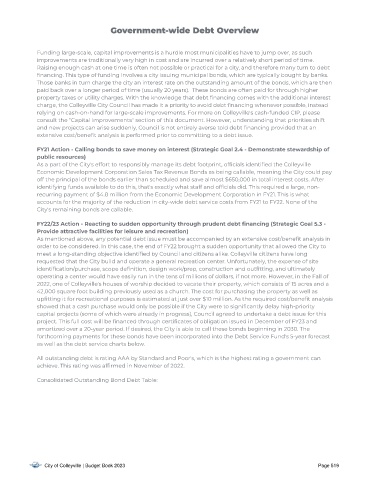Page 519 - CityofColleyvilleFY23AdoptedBudget
P. 519
Government-wide Debt Overview
Funding large-scale, capital improvements is a hurdle most municipalities have to jump over, as such
improvements are traditionally very high in cost and are incurred over a relatively short period of time.
Raising enough cash at one time is often not possible or practical for a city, and therefore many turn to debt
nancing. This type of funding involves a city issuing municipal bonds, which are typically bought by banks.
Those banks in turn charge the city an interest rate on the outstanding amount of the bonds, which are then
paid back over a longer period of time (usually 20 years). These bonds are often paid for through higher
property taxes or utility charges. With the knowledge that debt nancing comes with the additional interest
charge, the Colleyville City Council has made it a priority to avoid debt nancing whenever possible, instead
relying on cash-on-hand for large-scale improvements. For more on Colleyville's cash-funded CIP, please
consult the "Capital Improvements" section of this document. However, understanding that priorities shift
and new projects can arise suddenly, Council is not entirely averse told debt nancing provided that an
extensive cost/bene t analysis is performed prior to committing to a debt issue.
FY21 Action - Calling bonds to save money on interest (Strategic Goal 2.4 - Demonstrate stewardship of
public resources)
As a part of the City's effort to responsibly manage its debt footprint, of cials identi ed the Colleyville
Economic Development Corporation Sales Tax Revenue Bonds as being callable, meaning the City could pay
off the principal of the bonds earlier than scheduled and save almost $650,000 in total interest costs. After
identifying funds available to do this, that's exactly what staff and of cials did. This required a large, non-
recurring payment of $4.8 million from the Economic Development Corporation in FY21. This is what
accounts for the majority of the reduction in city-wide debt service costs from FY21 to FY22. None of the
City's remaining bonds are callable.
FY22/23 Action - Reacting to sudden oppor tunity through prudent debt {nancing (Strategic Goal 5.3 -
Provide attractive facilities for leisure and recreation)
As mentioned above, any potential debt issue must be accompanied by an extensive cost/bene t analysis in
order to be considered. In this case, the end of FY22 brought a sudden opportunity that allowed the City to
meet a long-standing objective identi ed by Council and citizens alike. Colleyville citizens have long
requested that the City build and operate a general recreation center. Unfortunately, the expense of site
identi cation/purchase, scope de nition, design work/prep, construction and out tting, and ultimately
operating a center would have easily run in the tens of millions of dollars, if not more. However, in the Fall of
2022, one of Colleyville's houses of worship decided to vacate their property, which consists of 15 acres and a
42,000 square foot building previously used as a church. The cost for purchasing the property as well as
up tting it for recreational purposes is estimated at just over $10 million. As the required cost/bene t analysis
showed that a cash purchase would only be possible if the City were to signi cantly delay high-priority
capital projects (some of which were already in progress), Council agreed to undertake a debt issue for this
project. This full cost will be nanced through certi cates of obligation issued in December of FY23 and
amortized over a 20-year period. If desired, the City is able to call these bonds beginning in 2030. The
forthcoming payments for these bonds have been incorporated into the Debt Service Fund's 5-year forecast
as well as the debt service charts below.
All outstanding debt is rating AAA by Standard and Poor's, which is the highest rating a government can
achieve. This rating was af rmed in November of 2022.
Consolidated Outstanding Bond Debt Table:
City of Colleyville | Budget Book 2023 Page 519

